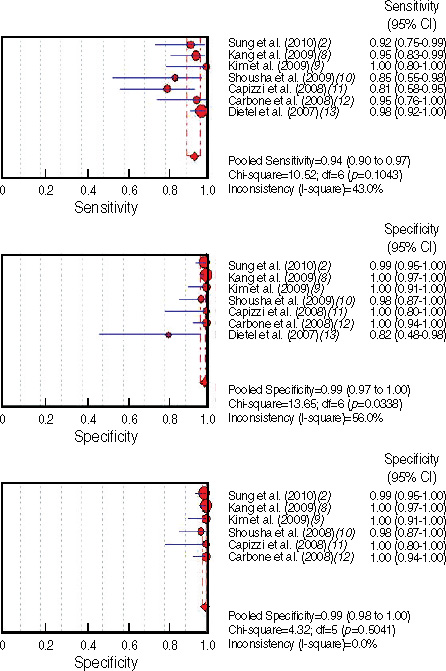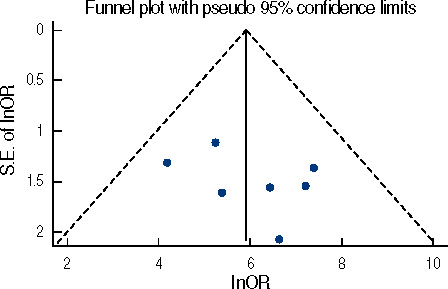J Breast Cancer.
2011 Feb;14(Suppl 1):S1-S9. 10.4048/jbc.2011.14.S.S1.
The Effectiveness of Silver In Situ Hybridization in Patients with Breast Cancer: A Systematic Review
- Affiliations
-
- 1Health Technology Assessment Department, National Evidence-Based Healthcare Collaborating Agency, Seoul, Korea.
- 2Department of Laboratory Medicine, Soonchunhyang University College of Medicine, Seoul, Korea.
- 3Department of Internal Medicine, Sungkyunkwan University School of Medicine, Seoul, Korea.
- 4Department of Surgery, Seoul National University College of Medicine, Seoul, Korea.
- 5Department of Internal Medicine, Soonchunhyang University College of Medicine, Seoul, Korea. parkhs@schmc.ac.kr
- KMID: 1340907
- DOI: http://doi.org/10.4048/jbc.2011.14.S.S1
Abstract
- PURPOSE
The purpose of this study was to evaluate silver in situ hybridization (SISH) as an effective test to identify HER2 gene amplification in patients with breast cancer.
METHODS
A systematic literature review was used to evaluate the effectiveness of SISH. The literature review covered from October 27, 2009 to December 1, 2009, and eight domestic databases including KoreaMed and foreign databases including Ovid-MEDLINE, EMBASE, and Cochrane Library were used. Keywords, such as 'silver in situ hybridization' and 'SISH', were used to search 63 documents. Ten studies regarding the evaluation of diagnostics were included in the final evaluation. The Scottish Intercollegiate Guidelines Network (SIGN) tool was used by two evaluators to independently evaluate the quality of the ten studies.
RESULTS
A total of ten studies (nine diagnostic evaluation studies and one correlation study) were identified to evaluate SISH. The effectiveness of this test was evaluated based on diagnostic accuracy, concordance rate, and correlation with fluorescence in situ hybridization (FISH) results. The sensitivity of SISH was 0.81-1.00, and the specificity was 0.82-1.00. The positive predictive value was 0.95-1.00, negative predictive value was 0.81-1.00, and the test accuracy was 0.90-1.00. The concordance rate of SISH was 87.0-100% and two studies reported a correlation with FISH results. The body of evidence as a whole suggests a Grade D for SISH.
CONCLUSION
SISH is a safe and useful procedure in patients with breast cancer and at least grade D evidence based on existing positive studies.
MeSH Terms
Figure
Reference
-
1. Sińczak-Kuta A, Tomaszewska R, Rudnicka-Sosin L, Okoń K, Stachura J. Evaluation of HER2/neu gene amplification in patients with invasive breast carcinoma. Comparison of in situ hybridization methods. Pol J Pathol. 2007. 58:41–50.2. Sung WJ, Park SJ, Gu MJ, Bae YK. Automated silver-enhanced in situ hybridization for evaluation of HER2 gene status in breast carcinoma: comparison with fluorescence in situ hybridization and immunohistochemistry. Korean J Pathol. 2010. 44:28–34.
Article3. Lee JW, Noh WC, Kim MS, Kim HA, Chang YH, Hong YJ, et al. Availability of fine needle aspirates for the assessment of HER2 gene amplification in invasive breast cancer patients. Korean J Lab Med. 2008. 28:392–399.
Article4. SIGN 50: a guideline developer's handbook. Scottish Intercollegiate Guidelines Network. Accessed January 22nd, 2011. http://www.sign.ac.uk/pdf/sign50.pdf.5. Health Insurance Review Agency. A Study on the Construction and Management of Health Technology Assessment System. 2005. Seoul: Health Insurance Review Agency;227–228.6. Bartlett JM, Campbell FM, Ibrahim M, Wencyk P, Ellis I, Kay E, et al. Chromogenic in situ hybridization: a multicenter study comparing silver in situ hybridization with FISH. Am J Clin Pathol. 2009. 132:514–520.7. Francis GD, Jones MA, Beadle GF, Stein SR. Bright-field in situ hybridization for HER2 gene amplification in breast cancer using tissue microarrays: correlation between chromogenic (CISH) and automated silver-enhanced (SISH) methods with patient outcome. Diagn Mol Pathol. 2009. 18:88–95.
Article8. Kang J, Kwon GY, Lee YH, Gong G. Comparison of silver-enhanced in situ hybridization and fluorescence in situ hybridization for HER2 gene status in breast carcinomas. J Breast Cancer. 2009. 12:235–240.
Article9. Kim TJ, Kim TE, Jung ES, Yim HW, Song BJ, Jung SS, et al. The comparison of automated silver in situ hybridization and fluorescence in situ hybridization for evaluating HER2 gene amplification in breast carcinoma. J Breast Cancer. 2009. 12:295–301.
Article10. Shousha S, Peston D, Amo-Takyi B, Morgan M, Jasani B. Evaluation of automated silver-enhanced in situ hybridization (SISH) for detection of HER2 gene amplification in breast carcinoma excision and core biopsy specimens. Histopathology. 2009. 54:248–253.
Article11. Capizzi E, Gruppioni E, Grigioni AD, Gabusi E, Grassigli A, Grigioni WF, et al. Real time RT-PCR approach for the evaluation of ERBB2 overexpression in breast cancer archival samples: a comparative study with FISH, SISH, and immunohistochemistry. Diagn Mol Pathol. 2008. 17:220–226.
Article12. Carbone A, Botti G, Gloghini A, Simone G, Truini M, Curcio MP, et al. Delineation of HER2 gene status in breast carcinoma by silver in situ hybridization is reproducible among laboratories and pathologists. J Mol Diagn. 2008. 10:527–536.
Article13. Dietel M, Ellis IO, Höfler H, Kreipe H, Moch H, Dankof A, et al. Comparison of automated silver enhanced in situ hybridisation (SISH) and fluorescence ISH (FISH) for the validation of HER2 gene status in breast carcinoma according to the guidelines of the American Society of Clinical Oncology and the College of American Pathologists. Virchows Arch. 2007. 451:19–25.
Article
- Full Text Links
- Actions
-
Cited
- CITED
-
- Close
- Share
- Similar articles
-
- Silver-Enhanced In Situ Hybridization as an Alternative to Fluorescence In Situ Hybridization for Assaying HER2 Amplification in Clinical Breast Cancer
- The Comparison of Automated Silver in situ Hybridization and Fluorescence in situ Hybridization for Evaluating HER2 Gene Amplification in Breast Carcinoma
- Automated Silver-enhanced In Situ Hybridization for Evaluation of HER2 Gene Status in Breast Carcinoma: Comparison with Fluorescence In Situ Hybridization and Immunohistochemistry
- HER2 Status in Gastric Adenocarcinomas Assessed by Immunohistochemistry, Automated Silver-Enhanced In Situ Hybridization and Fluorescence In Situ Hybridization
- Comparison of Silver-Enhanced in situ Hybridization and Fluorescence in situ Hybridization for HER2 Gene Status in Breast Carcinomas






